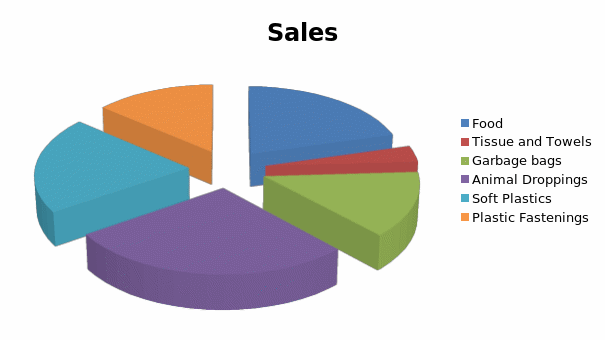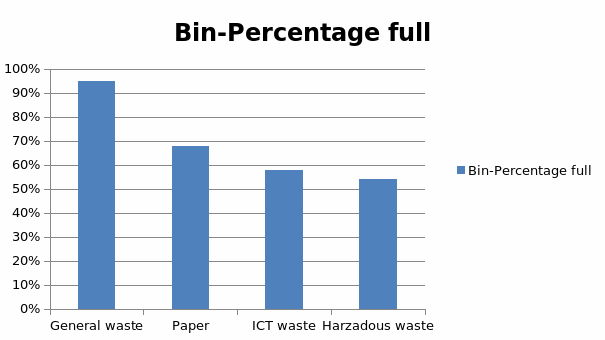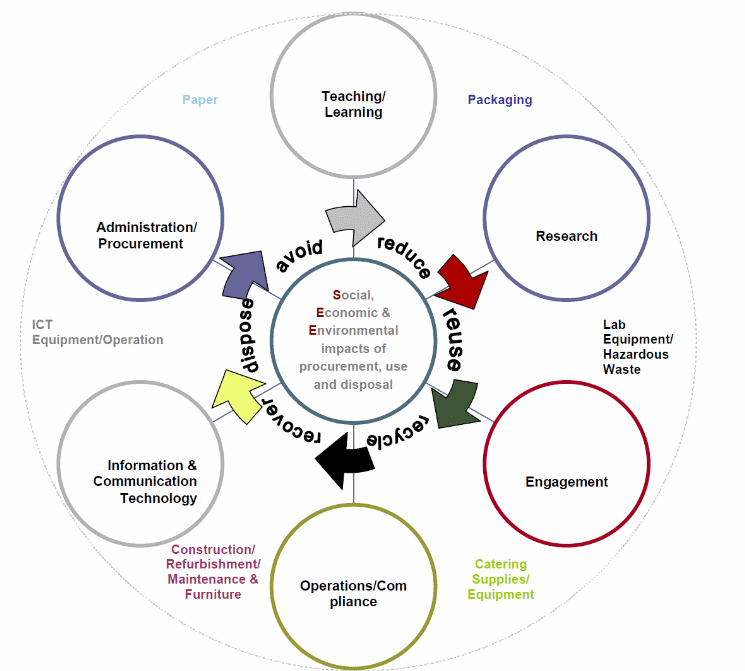Executive Summary
Waste management is vital in any organisation. Managers should have a waste management plan in place at their respective places of work. The University of Queensland is one of the largest and oldest learning institutions in the state of Australia, producing thousands of graduates every year. The institution also contributes to research and policy development in the country. The report focuses on one main campus of the institution located in St. Lucia. This campus started over 100 years ago. It covers over 114 hectares.
The methodology used in this report mainly consists of interviews, waste area assessment, and waste analysis. A survey was also conducted. The waste management assessment at the institution showed an efficient waste management plan in place. The main waste types produced at this institution include paper, food particles, hazardous waste from the laboratories, and the plastics mainly from the packaging materials.
A private contractor and the local city council do the collection and disposal of these wastes. The general waste is land filled while the rest of the waste is either recycled or incinerated. At the time of the collection of the waste from the bins, the bins are over 50% full, with the general waste bins being 95% full. Analysis of the data obtained from this waste assessment at the institution is provided in the report.
The recommendations from the analysis of waste management at the institution were based on the opportunities available. The institution has a waste minimisation strategy, which involves the reduction of materials for land filling to cut on the greenhouse gas emissions (EPA Information Bulletin, 1993).
The report recommends the creation of a committee at the institution to oversee the waste minimisation strategy, which should be headed by a qualified individual. The bulk of the organic waste can be reduced through inventory management at the catering department with some of the food materials being fed to animals such as pigs (Panikkar, Riley & Shrestha n.d). The proposed waste minimisation plan at the institution has a timeline of five years.
Background
Description of the Facility
The waste management plan developed in this paper is for the University of Queensland that is situated in Australia. The institution is among the oldest universities in Australia, having been started back in 1909. This public university has thousands of students in the many campuses, with the main campus being located near Brisbane city at a place called St. Lucia (Sweet 2008).
The facility is credited with the provision of higher education to students in Queensland and Australia at large. It has been ranked among the best performing institutions in the world.
The institution has over 2,000 teaching and non-teaching staff working all over the campuses. Apart from the training of students, the university is also tasked with research and development of policies in the various disciplines.
There have been a number of research works from the university. It operates a number of research facilities such as the Heron Island research station. The floor size of this institution is relatively large. No figure is provided for the combined space for all its campuses. However, the report will focus on waste management at the main campus at St. Lucia. This campus sits on 114 hectares.
The current waste management practices at the campus have been constantly revised. The institution has grown in terms of the number of students being enrolled. A simple system is used where private companies are contracted in the disposal of the waste. The institution has embarked on a waste minimisation strategy. The costs utilised in this system are mainly the bills used in the payment of the private companies contracted to collect the waste at the St. Lucia Campus.
Rationale for Waste Assessment
Several reasons reveal why waste assessment at the campus is crucial. The major reason for the assessment and development of the waste management plan is to allow the institution to comply with the state of Queensland and the Australian national policies on waste management.
The National Waste Policy of 2009 in Australia is geared towards the reduction of the disposed waste, thus ensuring environmental sustainability and providing associated economic and environmental benefits (Albu, & Chiţu 2011; Wei, Burritt, & Monroe 2011). Therefore, the university, which is a leader in policy formulation and implementation, is required to be at the forefront of the implementation of this policy.
The university also has a policy of engaging in clean and reliable processes in its operation. Environmental conservation is one of its policies. The waste assessment and management plan will contribute towards the development of an effective method for the institution to reduce its wastes and costs, thus ensuring that it lives up to the expectations of the society. The university has developed a number of waste management plans over the years. Most of the plans have the goal of waste minimisation.
Methodology
The objective of the exercise was to carry out a waste assessment at the institution in the effort of developing a waste management plan for St. Lucia Campus. The assessment of waste management at the St. Lucia Campus of Queensland University was done in various ways. Several methods including interviews, survey, collection of bins, and waste assessment were used to ensure that all the facts gathered concerning how the organisation handles its waste were available.
Interviews were conducted where the management was interviewed on the waste management plan in place, especially on the cost of the methods in place at the institution. The interviews were also conducted with the participation of other stakeholders such as students to establish the general waste management culture at the campus.
A survey was also conducted, with students and staff at the institution being evaluated in terms of waste management practices. This task was meant to establish whether the waste minimisation and management policies in place at the institution were working as anticipated.
The next step that was followed in the waste management assessment was the analysis of wastes in the institution for a period of one week together with the financial implications of the same for a month (EPA Victoria 2009). The process of waste collection and/or collection of bins was also assessed. After the analysis of the waste management system in the institution, the description of the waste generation process was possible.
The generation of waste at the St. Lucia Campus is a complex process where all shareholders in the institution are involved. The institution generates all kinds of wastes, including the organic and inorganic wastes. The organic wastes at the institution come from the cafeterias and the refreshment areas in the institution. Specially designed bins are in place to allow room for the collection of these wastes.
The other types of wastes generated at the institution include paper materials, plastics, and dung from the animals at the research centre. In every month, the organisation produces over 5 tonnes of waste. Several disposal routes are used in the organisation, including the contracting of garbage collection companies and private firms that do the same. The city council is also involved in the collection of waste from the institution.
The main problem encountered while carrying out the assessment of the waste management at the St. Lucia Campus of the University of Queensland is the lack of access to the kitchen areas where a more detailed assessment of the organic waste needed to have been done. There was also limited time to carry out the waste assessment, with limited information being available for the assessment. However, the waste assessment was fruitful. Therefore, the data obtained from this exercise will be discussed below.
Key Findings
Results from the Waste Assessment
From the waste assessment exercise at the St. Lucia Campus, a series of information can be obtained. The institution’s waste can be categorised into general waste, paper waste, ICT waste, and hazardous waste. The collection frequency for these varieties of waste ranges from daily to weekly. The main contractor is the St. Lucia City Council (The University of Queensland, Property & Facilities Division, Sustainability Office 2011).
The bulk of the waste collected is recycled for disposal, with the general waste being disposed by land filling at the City Council’s main waste disposal centre. The general waste is first sorted out at the institution, with various bins in place for the different types of wastes such as organic and inorganic wastes.
Inorganic wastes mainly come from the plastics, which are mainly used for packaging drinking water and other soft drinks at the institution’s catering areas. A summary of the waste management, including the types and collection frequencies were obtained and provided in the table below.
Table 1: Summary of waste management at St. Luis Campus
The general waste at the institution consists mainly of food particles from the dining area, hand towel and tissues from the sanitary areas, garbage bags, animal droppings, soft plastics, and plastic fastenings. The material types in paper waste include white paper, notes, shredded paper, and waxed cardboards.
Mails and other confidential materials are also present in the paper wastes. The ICT wastes consist mainly of computer materials, communication gadgets (Government of Victoria, 2013; Rudăreanu, 2013), and other ICT wastes from students (Bender, 2013). The hazardous wastes from the institution are mainly from the laboratories.
They consist mainly of used chemicals and reactants. These materials are not mixed with the general wastes. However, they are packaged in special materials that cannot react with the chemicals. An analysis of these components is provided below.
Table 2: Table showing the distribution of general waste

Pie Chart 1: Table showing the distribution of general wastes
An analysis of the bins showed that they were almost full in most of the instances before the collection of the waste. The percentage capacities for these bins were more than 50% occupied at the time of analysis. The analysis time was done before the collection of each of these bins. The general waste was the largest in amount, with the bins being 95% full at the time of analysis.
Table 3: percentage that the bins were full at the time of analysis

Graph showing the bin-percentage full in waste analysis at the institution
Analysis of Results
The institution has a number of waste minimisation opportunities. The reduction of the organic waste at the institution can be achieved through efficient procurement and inventory management at the catering department. Some of the food materials disposed are expired food products. The institution can put in place proper procurement strategies to reduce this form of waste. Through this opportunity, the organisation can reduce the amount of money it spends by about 20,000 dollars a month.
Opportunities are available in the institution such as a working incinerator, proper waste collection system, and organisation management. Such opportunities are aimed at reducing carbon emission through a reduction of wastes to b landfilled (EPA Victoria 1993). The institution also has a waste minimisation plan in place. This plan is scheduled to run for the next few years as shown in the figure below.

Figure showing the waste minimisation plan for University of Queensland. (Source: The University of Queensland, Property & Facilities Division, Sustainability Office, 2011)
Recommendations for Waste Minimisation
The aim of the future waste minimisation practice at the institution is the reduction of greenhouse gas emission and a cutback in the costs of waste disposal at the institution. The aim of any waste management and minimisation strategy according to Gakhar (2013) is to produce the greatest waste reduction in the greatest way possible.
The waste minimisation strategy for the institution should involve the identification of the existing practices in waste disposal, development of indicators of waste reduction performance, development of strategies and policies for waste reduction and identification of the implications of the proposed waste management plan.
The necessary actions include the formation of a committee to oversee the process of waste minimisation at the institution. A professional in waste management will lead this committee. The second plan will involve the creation of special designated areas of waste disposal at the institution where the inorganic waste and hazardous materials should be incinerated.
The other strategy to ensure reduction in waste is the reduction in the number of products sold at the catering department that are packaged with plastic materials. These products include water and soft drinks. The sizes of containers can be increased to ensure a reduction in the number of these containers.
The institution aims to reduce the greenhouse emissions from the landfill that the organic waste is disposed. One way of accomplishing this role is the reduction of organic waste being deposited in the landfills. The organic waste can be reduced through keeping of animals that can feed on the food materials.
Animals such as pigs may be used to consume the food materials, thus saving the institution in waste disposal and/or earning revenue for the institution. The timeline for the waste minimisation plan should be five years. All the components need to be functional by the end of this period.
References
Albu, R & Chiţu, I 2011, ‘Waste management within the context of waste management national strategy (WMNS) and regional waste management plan (RWMP) from centru region’, Bulletin Of the Transylvania University Of Brasov. Series V: Economic Sciences, vol. 4 no. 2, pp. 87-92.
Bender, A 2013, ‘Standards Australia un wrapse-waste standard for ANZ’, Cio, vol. 1 no. 1, p.13.
EPA Information Bulletin, 1993, Guidelines for Preparation of Waste Management Plans, Publication 383, Routlege, London.
EPA Victoria 1993, Waste Minimisation: Assessments and Opportunities for Industry, A Practical Guide to Cleaner Production’ Publication 351, Routlege, London.
EPA Victoria 2009, Industrial Waste Resource Guidelines: Introduction to the Environment Protection (Industrial Waste Resource) regulations, <www.epa.vic.gov.au/waste/docs/AttachmentCPIW-Disposal-Historical-Trends.pdf>.
Gakhar, S 2013, ‘An Effective Waste Management System for a Better Future’, Aweshkar Research Journal, vol. 15 no. 1, pp.129-136.
Government of Victoria 2013, Getting full’ value the Victorian waste and resource recovery policy, Finsbury Green, <www.dse.vic.gov.au/waste>.
Panikkar, A, Riley, S & Shrestha, S n.d, ‘Risk Management in Vermi composting of Domestic Organic Waste’, Environmental Health, vol. 4 no. 2, p.11.
Rudăreanu, C 2013, ‘Waste electrical and electronic equipment (WEEE) management in Europe’, Economics, Management &Financial Markets, vol. 8 no. 3, pp. 119-125.
Sweet, M 2008, ‘It’s Time the University of Queensland Came Clean Properly’, New Doctor, vol. 88 no. 1, p. 17.
The University of Queensland, Property & Facilities Division, Sustainability Office 2011, Waste Minimisation Plan, The Sustainability Office, Waste Minimisation Plan 2010-2015, The University of Queensland, Australia.
Wei, Q, Burritt, R & Monroe, G 2011, ‘Environmental management accounting in local government: A case of waste management’, Accounting, Auditing & Accountability Journal, vol. 24 no. 1, pp. 9-128.